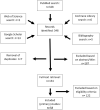Distraction osteogenesis versus induced membrane technique for infected tibial non-unions with segmental bone loss: a systematic review of the literature and meta-analysis of available studies
- PMID: 37921889
- PMCID: PMC11249469
- DOI: 10.1007/s00068-023-02375-w
Distraction osteogenesis versus induced membrane technique for infected tibial non-unions with segmental bone loss: a systematic review of the literature and meta-analysis of available studies
Abstract
Introduction: Infected tibial non-unions with associated bone loss can be challenging to manage. At present, the two main methods utilized in the management of these fractures include the Ilizarov technique of Distraction Osteogenesis (DO) using external fixator devices, or alternatively, the Induced Membrane Technique (IMT), devised by Masquelet. As there is a paucity of data directly comparing the outcomes of these techniques, there is no universal agreement on which strategy a surgeon should choose to use.
Aims: This systematic review and meta-analysis aimed to summarize the outcomes of both DO and IMT, in terms of primary outcomes (bone union and infection elimination), and secondary outcomes (complication rates and functional outcomes).
Methods: A PRISMA strategy was used. Medline, Web of Science, Cochrane Central Register of Controlled Trials (CENTRAL), and Google Scholar library databases were interrogated using pre-defined MeSH terms and Boolean operators. Quality of evidence was evaluated using OCEBM and GRADE systems.
Results: Thirty-two studies with 1136 subjects met the inclusion criteria. With respect to the primary outcomes of interest, union was observed in 94.6% (DO method) and 88.0% (IMT method); this difference, however, was not significant between the two techniques (p = 0.45). In addition, infection elimination rates were also higher in the Ilizarov DO group when compared to Masquelet (Mq) IMT (93.0% vs 80.4% respectively). Again, no significant difference was observed (p = 0.06). For all secondary outcomes assessed (unplanned re-operations, re-fracture rates amputation rate), no statistically significant differences were documented between the treatment options.
Conclusion: This study demonstrated that there is no clinical difference in outcomes for patients treated with Ilizarov DO versus Mq IMT techniques. The evidence base at present is relatively sparse and, therefore, we would recommend for further Level I studies to be conducted, to make more meaningful conclusions.
Keywords: Bone defect; Distraction osteogenesis; Induced membrane technique; Infection; Masquelet; Non-union; Tibia.
© 2023. The Author(s).
Conflict of interest statement
The authors have no relevant financial or non-financial interests to disclose. The authors have no conflict of interest to declare that are relevant to the content of this article. All authors certify that they have no affiliations with or involvement in any organization or entity with any financial interest or non-financial interest in the subject matter or materials discussed in this manuscript. The authors have no financial or proprietary interests in any material discussed in this article.
Figures



Similar articles
-
Intracavity lavage and wound irrigation for prevention of surgical site infection.Cochrane Database Syst Rev. 2017 Oct 30;10(10):CD012234. doi: 10.1002/14651858.CD012234.pub2. Cochrane Database Syst Rev. 2017. PMID: 29083473 Free PMC article.
-
Systemic pharmacological treatments for chronic plaque psoriasis: a network meta-analysis.Cochrane Database Syst Rev. 2021 Apr 19;4(4):CD011535. doi: 10.1002/14651858.CD011535.pub4. Cochrane Database Syst Rev. 2021. Update in: Cochrane Database Syst Rev. 2022 May 23;5:CD011535. doi: 10.1002/14651858.CD011535.pub5. PMID: 33871055 Free PMC article. Updated.
-
Cephalomedullary nails versus extramedullary implants for extracapsular hip fractures in older adults.Cochrane Database Syst Rev. 2022 Jan 26;1(1):CD000093. doi: 10.1002/14651858.CD000093.pub6. Cochrane Database Syst Rev. 2022. PMID: 35080771 Free PMC article.
-
Systemic pharmacological treatments for chronic plaque psoriasis: a network meta-analysis.Cochrane Database Syst Rev. 2017 Dec 22;12(12):CD011535. doi: 10.1002/14651858.CD011535.pub2. Cochrane Database Syst Rev. 2017. Update in: Cochrane Database Syst Rev. 2020 Jan 9;1:CD011535. doi: 10.1002/14651858.CD011535.pub3. PMID: 29271481 Free PMC article. Updated.
-
Ultrasound and shockwave therapy for acute fractures in adults.Cochrane Database Syst Rev. 2012 Feb 15;(2):CD008579. doi: 10.1002/14651858.CD008579.pub2. Cochrane Database Syst Rev. 2012. Update in: Cochrane Database Syst Rev. 2014 Jun 23;(6):CD008579. doi: 10.1002/14651858.CD008579.pub3. PMID: 22336847 Updated.
Cited by
-
Introducing the Pearl-String Technique: A New Concept in the Treatment of Large Bone Defects.Life (Basel). 2025 Mar 7;15(3):414. doi: 10.3390/life15030414. Life (Basel). 2025. PMID: 40141759 Free PMC article.
-
Masquelet technique including a multiperforated non-vascularized fibula graft for the reconstruction of massive post-traumatic bone defects in military practice.Eur J Trauma Emerg Surg. 2025 Feb 1;51(1):90. doi: 10.1007/s00068-024-02722-5. Eur J Trauma Emerg Surg. 2025. PMID: 39891669
-
Cable-asisted bone transport versus circular external fixators-asisted bone transport in the management of bone defects of the Tibia: clinical and imaging results.J Orthop Surg Res. 2025 Mar 12;20(1):264. doi: 10.1186/s13018-025-05648-9. J Orthop Surg Res. 2025. PMID: 40069761 Free PMC article.
-
Effectiveness of the induced membrane technique in aseptic and infected long-bone defect management: Are there any differences?World J Orthop. 2025 Jul 18;16(7):107337. doi: 10.5312/wjo.v16.i7.107337. eCollection 2025 Jul 18. World J Orthop. 2025. PMID: 40698281 Free PMC article. Review.
-
Management of Infected Tibial Nonunion: Combining Synthetic Bone Grafting with Continuous Local Antibiotic Perfusion (CLAP).Am J Case Rep. 2024 Sep 13;25:e945023. doi: 10.12659/AJCR.945023. Am J Case Rep. 2024. PMID: 39267305 Free PMC article.
References
Publication types
MeSH terms
LinkOut - more resources
Full Text Sources
Medical
Research Materials
Miscellaneous

